Novelty Clashes with Tradition
Atila S. Guimarães
I will try to answer these questions and give some assistance to these readers.
Origin of the Rosary
No Catholic doubts that St. Dominic of Guzman had a decisive role in the dissemination of the Rosary. In the year 1214 he received a revelation from Our Lady in Toulouse, France, telling him to place the new Order of Preachers he had founded under her protection through the praying and spreading of the Rosary.
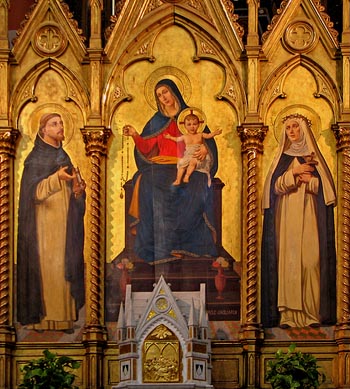 Our Lady gives the Rosary to St. Dominic Dominican Church of the Holy Rosary, Rome |
So, for these scholars, Our Lady would have only asked St. Dominic to follow that already existing but incomplete practice. The second part of the prayer – Holy Mary, Mother of God ... – would have been introduced later, along with the Our Fathers and the meditations on the sorrows and glories of Our Lady and her Divine Son. Only in the 15th century, in a revelation to Fr. Alain de la Roche, would the 15 mysteries in the form we know today have been established. Such is the opinion of this particular school. This opinion is very convenient for the Progressivists who promote the new luminous mysteries, since based on this reasoning they can pretend the Rosary has always been a changing and evolving prayer.
Other scholars disagree with this evolutionary school and consider that from St. Dominic on, the Rosary devotion was as it is now. They argue:
First, that the actual origin of the “crowns of roses” was established as a practice of the simple medieval people, who were not able to read and therefore could not pray the Hours of the Divine Office, also called the Psaltery, as was the habit among educated Catholics. Thus, instead of reciting the 150 Psalms, they started to pray 150 Hail Marys in honor of Our Lady as a substitute for the Holy Office. According to this school, from the very beginning, the Rosary included not only joyful meditations on the life of Our Lady and her Son, but also, inspired by the Psalms, sorrowful and glorious meditations.
Second, they say that it seems ludicrous and most improbable that Our Lady would ask St. Dominic to pray an incomplete Rosary, and then reveal to one of his disciples and other Catholics that what she really wanted was a complete Rosary. Given that she had intended to give us the complete Rosary, the prayer that most pleases her, this practice should have only one form, not two. Why would she, who is the Seat of Wisdom and always knew what she wanted to establish, conceal the complete form of the Rosary to the Dominican founder and only reveal it in the 15th century to one of his disciples? It is much more probable that she revealed the complete Rosary to St. Dominic, and when that devotion started to decline, she appeared again to reinforce the practice of that same original Rosary.
However, Progressivists considered the hypotheses of the evolutionary school as “proved” and started to treat the venerable tradition that says St. Dominic received the entire Rosary as a legend. Today, unfortunately, it is not rare to find this superficial interpretation promoted even in Dominican Institutions.
My sympathies are with the second school, and I have serious suspicions regarding the first. The latter fits neatly with today’s progressivist historic method of reexamining and changing almost everything that was already established by Church tradition. It also plays into ecumenism, which wants to minimize Marian devotions as much as possible to please Protestantism. We know that when Progressivists and Protestants cannot destroy a certain devotion, they try to sabotage it and present it as baseless and superstitious.
Leo XIII closes the discussion: St. Dominic received the complete Rosary
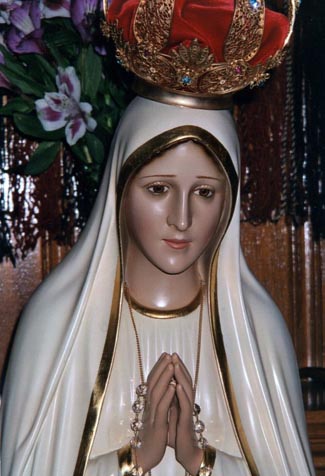 At Fatima Our Lady asked for the 15-decade Rosary |
In the Encyclical Octobri mense, Leo XIII affirms: “We are pleased to point out and strongly recommend the holy Rosary. To this manner of prayer was given, in common language, the name of ‘crown,’ because it recalls to our minds, in an opportune sequence, the great mysteries of Jesus and Mary: their joys, sorrows and triumphs.” (1)
In the next paragraph, the Pontiff completes his thought: “That the Queen of Heaven herself has granted a great efficacy to this devotion is demonstrated by the fact that it was, by her command and counsel, instituted and propagated by the illustrious St. Dominic, in times particularly dangerous for the Catholic cause.” (2)
That is, Leo XIII considers as historically proved (please, go to n. 3) that the three sets of mysteries he described were given as such by Our Lady to St. Dominic. In other words, according to this Pontiff, it was by the express wish of Our Lady that the three sets of mysteries were established.
The Most Holy Virgin confirms the three sets of mysteries
This decision was confirmed by the Most Holy Virgin in several of her apparitions.
In 1460, more than two centuries after that first communication to St. Dominic, when the Rosary devotion was in decline, she appeared to another Dominican, Alain de la Roche, to confirm her first intention. She told him to spread the Rosary devotion with the same form: 150 Hail Marys distributed in three sets of five mysteries.
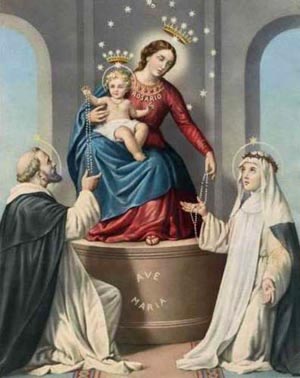 Our Lady of Pompeii recommended the traditional Rosary |
“My son, you know perfectly the ancient devotion of my Rosary, preached and diffused by your Patriarch and my Servant Dominic and by his spiritual sons, your religious brothers. This spiritual exercise is extremely agreeable to both my Son and to me, and most useful and holy for the faithful.
“When my Servant Dominic started to preach my Rosary … the reform in the world reached such heights that it seemed that men were transformed into angelic spirits and that Angels had descended from Heaven to inhabit the earth. … No one was considered a true Christian unless he had my Rosary and prayed it. … The prestige of the holy Rosary was such that no devotion was or is more agreeable to me after the august Sacrifice of the Mass. …
“I desire, therefore, that it [the devotion of the Rosary] be restored again in the Church for the consolation of a great number of souls. You will be the one to preach my Rosary, exhorting all the faithful to pray it devoutly. … The Rosary will be a most powerful weapon against Hell; it will subdue vices, destroy sin and conquer heresies. All those who will recommend themselves to me through my Rosary will not be eternally condemned.” (3)
In the apparitions of Our Lady of Pompeii in 1884, which were praised by Pius XII (see two paragraphs below), Our Lady said, “If you seek salvation, promulgate the Rosary.” She appeared with the same Rosary that we pray.
If some doubt remains that Our Lady wants the Rosary as she gave it to St. Dominic, we can see that in 1858 at Lourdes she taught Bernadette how to pray that same Rosary. This is affirmed by Pope Pius XI in the Encyclical Ingravescentibus malis: “And we do not wish to pass over in silence the fact that the Blessed Virgin herself, in our very epoch, has insistently recommended this manner of prayer when, appearing to an innocent girl in the Grotto of Lourdes, she taught her the recitation of the Rosary.” (4)
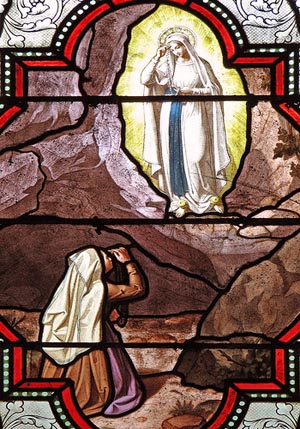 Our Lady teaches the Rosary to St. Bernadette in Lourdes |
In Fatima, something similar happened. In all the apparitions there, Our Lady, dressed in white, held her Rosary in her folded hands, and counseled the children to pray the Rosary. Further, in the last apparition of October 13, 1917, she also appeared as Our Lady of the Rosary, displaying the traditional Rosary.
Since in these apparitions Our Lady always expressed her desire for the Rosary to be prayed as we know it, why would she tell St. Dominic to pray a different Rosary? Nothing seems less probable. If she told all the other seers the same thing – to pray the Rosary as we know it – she certainly ordered the same to St. Dominic. Therefore, the old Dominican tradition is correct in attributing to St. Dominic the complete Rosary – the 150 Hail Marys, 15 Our Fathers and Glory be's and the three sets of mysteries. The revisionist and evolutionary school is wrong.
Therefore, Our Lady desires the Rosary as it has been prayed since St. Dominic, and nothing else. Hence, the innovation of John Paul II does not attend to her expressed wish. Rather it seems to sabotage it by introducing another set of mysteries at his own personal initiative.
The three sets of mysteries and the previous Popes
The Popes also confirmed with their authority the excellence of the Rosary.
Pope Urban IV in 1261, less than 50 years after the introduction of the Rosary by St. Dominic, approved it and gave special indulgences to the Confraternities of the Blessed Virgin that prayed the Rosary.
Pope John XXII (1316-1334) confirmed the excellence of the same fifteen-decade Rosary and increased those indulgences.
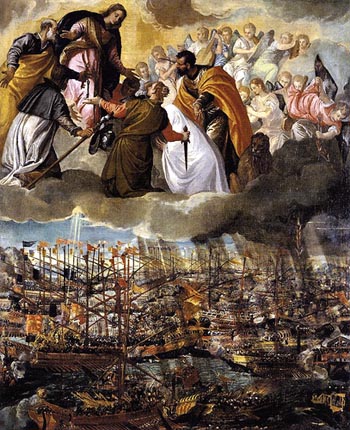 Thanks to the Rosary, Our Lady gave the victory at Lepanto |
It would take too long to recount all the Popes who praised and blessed the Rosary as we know it. (6) Let me only reproduce a text by Leo XIII where he presents five Popes who approved the Rosary:
“After having repeatedly encouraged … the recitation of the Holy Rosary, we, following the example of our predecessors, have endeavored to increase its importance by a more solemn cult. Sixtus V, of happy memory, approved the ancient custom of praying the Rosary; Gregory XIII instituted the feast of the Rosary, which Clement VIII afterward inscribed in the Roman Martyrology, and Clement XI extended to the whole Church; later Benedict XIII inserted it in the Roman Breviary. So, we, in perpetual testimony of our appreciation for this devotion, have decreed that said feast and its Office should be celebrated in the universal Church … consecrating to this devotion the entire month of October.” (7)
In his Encyclical Fidentem piumque, Pope Leo XIII opposes any change to the structure of the Rosary: “And that old usage that flourished among our forefathers ought to be preserved with religious exactitude or else restored, according to which Christian families, whether in town or country, considered it a sacred duty to gather together at close of day, when their labors were at end, before a statue of the Virgin and alternately pray the Rosary.” (8)
Conclusion
We can see, therefore, that in many important apparitions, Our Lady asks Catholics to pray the Rosary as we always knew it – the Creed, the introductory Our Father, three Hail Marys, and Glory be; and the body of 150 Hail Marys, 15 Our Fathers, and 15 Glory bes divided into three sets of five mysteries, the Joyful, Sorrowful and Glorious. It seems quite clear that the innovation of John Paul II is opposed to the expressed will of Our Lady.
After exposing the praises and comments of many Popes, as well as referring to the indulgences and blessings they gave for praying the traditional Rosary, it seems quite clear that to pray a different rosary of four sets of mysteries causes this rosary to lose the merit of those eulogies and blessings. In other words, whosoever prays the new sets of mysteries would seem not to benefit from the previous indulgences and graces.
In summary, far from being a benefit, this new set of Luminous Mysteries caused a serious damage. It subverted an august 800-year-old devotional practice. Adding an additional 50 Hail Marys was an extravagance that did not lead more persons to adopt the practice of the Rosary; it made it more difficult for those who already prayed it. This addition of John Paul II, introduced on a personal whim, seems to me a hypertrophy that is producing an atrophy in the devotion of the Rosary. I wonder whether this atrophy was actually intended to sabotage the Rosary devotion.
1. Leo XIII, Encyclical Octobri mense of September 22, 1891, § 17
2. Ibid. § 18.
3. Louis Grignion de Monfort, O Segrêdo de Maria & Método de Rezar o Rosário, Rio: Santa Maria, 1953, Preface to the second part, pp. 79-80
4. Pius XI, Encyclical Ingravescentibus malis of September 29, 1937, § 8.
5. Pius XII, Allocution Venuti come siete of October 8, 1941, § 12.
6. The praying of three sets of mysteries as an unchanging practice in the Church was commented on directly by these Popes:
Pope Leo XIII: Encyclical Octobri mense of September 22, 1891. § 17; Encyclical Magna Dei Matris of September 8, 1892, § 5; Encyclical Laetitiae sanctae of September 8, 1893, §§ 6-16; Encyclical Jucunda semper of September 8, 1894, §§ 5-7, 12-14; Encyclical Adjutricem populi of September 5, 1895, § 14; Encyclical Fidentem piumque of September 20, 1986, §§ 8, 9;
Pope Pius XII: Allocution Di gran cuore of October 16, 1940, §§ 5-9; Encyclical Ingruentium malorum of September 15, 1950, § 6.
7. Leo XIII, Encyclical Diuturni temporis of September 5, 1898, § 4.
8. Leo XIII, Encyclical Fidentem piumque of September 20, 1896, § 4.
